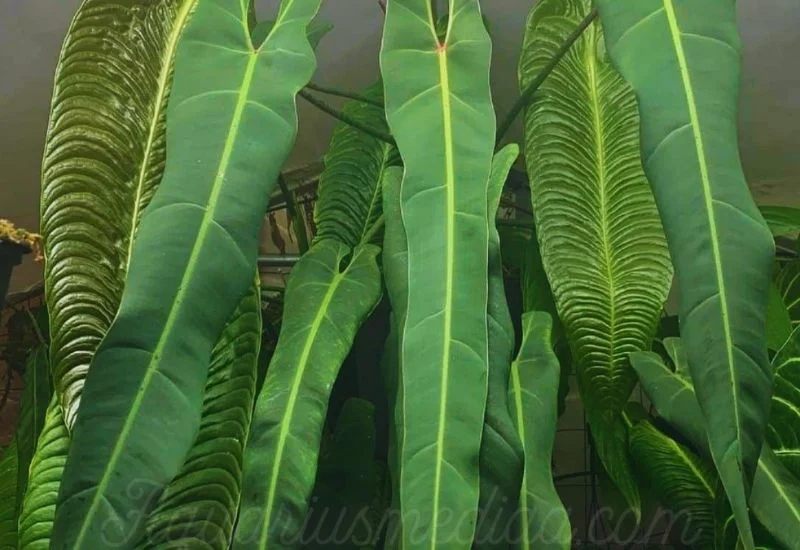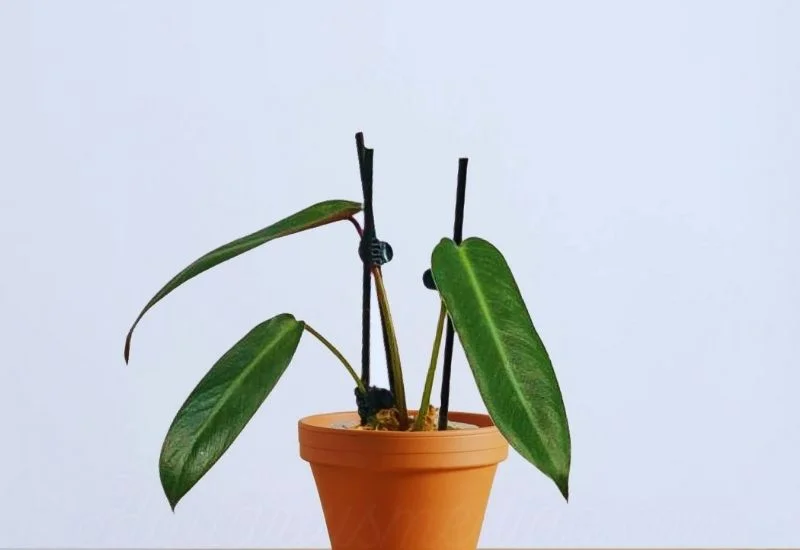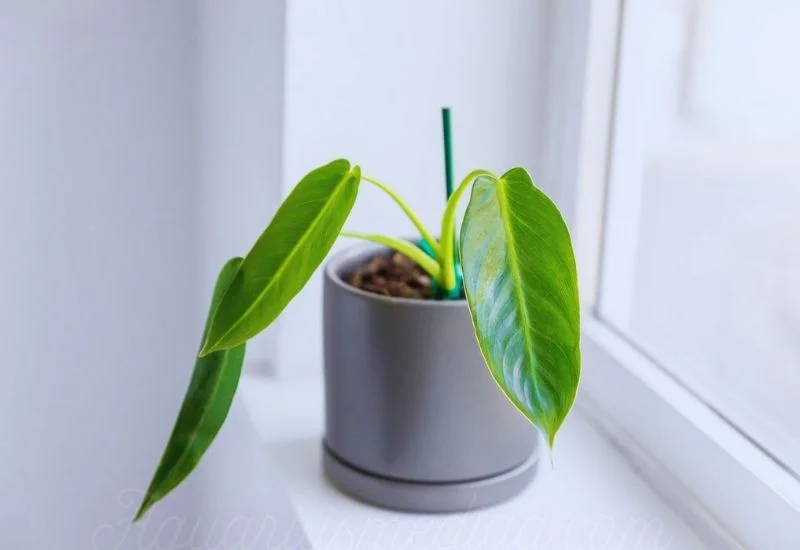In this blog post, you’re going to learn how to easily propagate and care for Philodendron spiritus-sancti.
This is a comprehensive guide covering reliable information about different aspects of this cultivated variety.
In this post, I’ll cover:
- Interesting Facts
- Propagation
- Repotting
- Care
And
- Solutions to Common Problems
So, if you are looking to propagate and care for Philodendron spiritus-sancti, this guide is for you.
Fun Facts
| Common Name | Santa Leopoldina |
| Botanical Name | Philodendron spiritus-sancti |
| Family | Araceae |
| Plant Type | Vine |
| Fruit | Berry-like |
| Mature Size | 65 feet long, 6 feet wide |
| Sun Exposure | Indirect light or partial shade |
| Soil Type | Well draining soil |
| Soil pH | 5.5-6.5 |
| Native Area | Brazil |
| Toxic | Toxic due to calcium oxalate crystals |
| Growth | In warmer environment with humidity |
Philodendron spiritus-sancti is an endangered species within the group of the Philodendron genus. It is native to Brazil and a rare plant by nature because of its rarity and leaves, which can be used to decorate plant lovers’ collections. This type of philodendron has long leaves and an interesting pattern of growth.
Unlike other philodendrons the spiritus sancti will grow averagely slow and the plant requires specific conditions to grow and blossom. However, it is difficult to grow outside its natural environment.
P. spiritus-sancti prefers growing in its saprophytic phase, so it has a slower growth rate. Its growing climatic condition is closely similar to its natural environment of the tropical zone (a lot of heat and humidity). Maximum growth is achieved when the plant gets sufficient light and the water at moderate level. This philodendron tends to grow all year round in its natural habitat.
The visibility of Philodendron spiritus-sancti is connected to the leaves of this plant. They are long and slender, like a lance, and can be up to several inches long to several feet in length. The pattern of the leaf has a central main nerve with secondary nerves or sub-nerves that interlock in a specific manner.
The leaves are normally dark green and have a glossy look. This attribute gives a dramatic feel to the plant.
Flower Structure and Fruiting

The sexual structure of this is just like most members of its family. Flower comprises a spadix (a leafy structure alternative to the petal) that is surrounded by a spathe (a green part covering the spadix).
The occurrence of the plant-to-flower is quite rare. The flowers, which are less prominent than the foliage, are vital in the reproduction of the plant.
The fruiting structure in this species develops over the spadix. Every berry-like fruit has visible seeds that are vital to the germination process. While in the natural environment, they are spread by animals. The fruit takes several months to ripen and to have seed germination.
Benefits
P spiritus-sancti has several advantages that are described below;
Its large leaves have an elongated shape, which looks very impressive and makes it a choice for indoor plants. Such attractiveness can perfect the matters of aesthetic interest and beauty of interiors.
Like many other philodendrons, the spiritus-sancti enhances the quality of fresh air. It assists in clearing toxins from the air as well as enhancing the quality of oxygen, which makes the living conditions much healthier. This makes it not only an aesthetic piece but a practical piece for interiors as well.
Philodendron spiritus-sancti is a rare plant and its availability is extremely limited, which is why many people consider it to be one of the symbols of their status among the fans of exotic plants.
The growth rate of Philodendron spiritus sancti and specific care may be work for those people who like to have a plant caretaking challenge.
The successful raising of this plant can help in learning about plant care and all the methods that are involved in the proper development of plants.
Uses

P. spiritus-sancti is mostly grown for its aesthetic appeal. It also has some useful contributions;
Ornamental Gardening
Being one of the many Philodendron species, it is highly demanded among those who like to grow beautiful plants in their home and collect indoor plants.
Interior Decoration
Due to its elongated leaves with a brightly green color it is appropriate for use for interior decor. It can beautify dwellings’ living spaces, workplaces, and other interiors, bringing the natural beauty of water indoors.
Air Purification
It helps to purify the air and is useful in the clearing of gasses, fresh air to the room, and generally enhances the quality of air inside a given house.
Botanical Research
P. spiritus-sancti grows only in a few places in the world and is of interest to scientists and conservationists. This is important in tutoring about the balance of life as well as the function of the species of the tropics.
Educational Purposes
These plants act as the educational displays at the botanical gardens and other related institutions. It can also be applied in scientific research specially in botany for the analysis of morphology, adaptations, and taxonomy of plants.
Propagation
The propagation of the P. spiritus-sancti is relatively easy but not very common. So, its cultivation is interesting and engaging. Here are the key steps and considerations to successfully propagate this unique plant.
Step-by-Step Guide to Propagation
Unfortunately, propagating Philodendron Spiritus Sancti has limited options. A well-known technique is stem cutting. It is propagated by the stem-cutting method in this way;
Selection of Stem: Choose a healthy, mature stem which is at least one node with few leaves on it.
Preparing the Cutting: To take the cutting, a clean and sharp knife or a pair of scissors is required, and a cutting is made just below a node. Make sure that the cutting must be at least 4-6 inches long and contain a couple of leaves.
Cut the lower part of the cutting and detach leaves to reveal the node (from where the roots will emerge).
Rooting Medium: One can put the cutting in water or into a potting mix that has good drainage capacity. In the case of using water, ensure that it is fresh and replaced in time to avoid bacterial growth and spoilage.
Right Environment: It recommended that high humidity should be maintained around the cut to help promote root formation. This can be done by putting a plastic paper over the cutting or putting it in a tight container (humidity dome).
Store the cutting in a warm area and place it in a location where it gets indirect, bright light.
Monitoring and Care: Examine the roots occasionally. In water, you should be able to observe that roots are starting to form within a week or two. In soil, it is done in a few weeks.
Once the cutting has a good root system, it can be transferred to a pot with good drainage and good soil.
Transplanting: Select a pot with drainage holes and use appropriate soil (including orchid bark, perlite, and peat moss).
Ongoing Care: Keep on increasing the amount of humidity, and do not forget about the irrigation; let the soil get slightly dry before watering. In the growing season feed the plant with a balanced diluted fertilizer.
Air Layering (Optional): This method involves promoting the formation of roots on the selected stem while it is still on the mother plant. Though it is expensive, it is mostly applied in situations where plants of high value and rare species are being grown.
Repotting

Repotting of Philodendron species is crucial for their maintained growth and best survival. Because of the climbing nature, extra care is needed during transplanting. Here are the steps and considerations for repotting this rare plant:
Timing
The ideal period for repotting Philodendron spiritus-sancti is the period of growing season (spring or early summer). It also helps the plant to put out fresh roots more quickly and to get back on its feet readily.
Choosing the Right Pot
Choose a pot that is much larger than the present pot. The pot should have drainage holes to avoid water logging.
Preparing the Potting Mix
Choose the correct type of the soil that is well-draining and has a good aeration capability. Some of the best types of mixes are orchid bark, perlite, and peat moss.
Removing from the Old Pot
Carefully break the soil around the roots without making any cuts on the roots. Sometimes, the roots may be compacted, so loosen them with moisture before proceeding.
Inspecting the Roots
Look for the roots, whether they are rotten or damaged. Cut off any black, spongy, or rotting roots with a sterilized sharp scissor or a sharp pruner.
Repotting the Plant
Put a layer of fresh potting mix at the bottom of the new pot. Size of pot also matters as some pots are large enough to accommodate all the roots of plant. Place the plant in the middle of the tank and set out the roots.
Spread potting mix over the roots and tap lightly to remove the air in the mixture. Check to make sure the plant stands steady and is at the same height as it was in the previous container.
Watering
After repotting is done, it is advisable to water the plant so as to have the soil pack well around the plant’s roots. Pour out the water until the potting medium should only be moist but not water logged.
Post-Repotting Care
After repotting the plant in an appropriate soil mix, place it in the bright, indirect light. Do not place the plant into direct sunlight as it can stress the plant.
The plant needs to be provided with a high-humidity environment, particularly if it was recently repotted. This can be done by spraying the plant or using a humidity tray.
It is necessary to inspect the plant regularly to identify if ever it experiences stress, in the form of wilting or yellowing leaves. The water level should be maintained but not over-water it.
Fertilization
Once the new shoots of the plant emerge, it is advisable to resume the usual feeding routine. Apply a fertilizer that is diluted to ensure that the plant grows well.
Care
P. spiritus-sancti cannot be classified as an easy-care plant, unlike other Philodendron species. From the perspective of the following matters, it requires dedicated care:
Pruning
Pruning is essential for the healthy growth and looking of the plant. With the passage of time, some leaves have gone unhealthy and rotten. The removal of these parts also prevents the plant from diseases. Use the sharp knife, pruner or scissors to remove these sections.
Soil
A well-draining soil enriched with the nutrients and organic matters included is a best option. The pH of soil ideally be slightly acidic to neutral (5.5-7.0). The soft structured soil helps in aeration and better growth.
Pot
The selection of the pot is an important parameter in the safe growth of P. spiritus-sancti. Pot size should be enough to provide a proper space to roots for growth. A larger pot than required will hold water and lead towards waterlogging. It is advised to change the pot every 2-3 years.
Water
Water the plant wisely. The upper layer of soil should dry up to a few inches. There is neither soil being too dry nor waterlogging. Water more during spring and summer when growth is at its peak.
Light
Ensure a bright, indirect light to the plant. Direct light can burn its leaves, and very low light can stunt growth. The best place for this plant is beside windows covered with curtains.
Fertilizer
It is directed to give a water-soluble fertilizer to the plant, which is easily available to the plant. Apply fertilizer within every 4-6 weeks. Maintain a proper routine during the growing season. Don’t over-fertilize the plant. It can lead to burning due to an overdose of nutrients.
Placement
P. spiritus-sancti requires an indirect light. It is a completely shady place with temperature 18° to 27°C. A place with a steady air flow is best for its survival. The humidity level of 60%-70% encourages its growth. Keep it away from the direct sunlight otherwise it will wilted and burn.
Common Problems
Here, a few common issues that can be irritating the gardner are described with their reasons;
Pests
Pests are always with the plants. They have both beneficial and harmful effects on the plants. Philodendron spiritus sancti like any other house plants is sensitive to some pests like aphids, the spider mites as well as the mealy bugs.
The pests suck the sap from the plant, which leads to stunted growth and also damages the leaves and stems. To reduce the impact of these pests, spray the plant with natural insect repellants or insecticidal soap.
Fungal Diseases
Fungi can also attack the P. spiritus-sancti like pests. Damped conditions, waterlogging and low air passage are the conditions that encourage the fungal production. Ensures the proper drainage system of pot to avoid the waterlogging and a flow of fresh air.
Brown Tips
Brown tips on the apex of leaves in philodendrons can be a result of waterlogging, low humidity, or over-fertilizing. Fertilize the plant wisely, don’t overwater. Make sure you are providing the right and balanced diet to plants.
Curling Leaves
Despite lack of water and low humidity, the curling of leaves may be a sign of unfavorable temperature. Place a plant at a suitable temperature limit, rewater it, and maintain humidity to tackle it.
Yellow leaves
Lack of adequate light, over-watering and lack of nutrients leads to the yellowing of leaves. Make sure the plant is exposed to the bright indirect light and a required humidity is maintained.
Varieties & Similar Plants
Philodendron spiritus-sancti is a special member of the philodendron with long leaves and prominent veins. It is slow-growing and unique in its features. So, it’s very hard to get a plant of this species that is very close to it. Let’s discuss some similar plants to this:
Philodendron gloriosum
P. gloriosum is a type of philodendron with a heart and large green leaves with white veins. It is a little bit different in morphology but has the same aesthetic appeal as spiritus-sancti.
Philodendron Melanochrysum
This species has black leaves with appealing yellow venation. This one also has a glossy look, just like a P. spiritus-sancti.
Philodendron Hederaceum (Heartleaf Philodendron)
Heartleaf Philodendron is the most common plant in the philodendron family. It has heart-shaped leaves that are dark green in color. This plant also has a similar vining characteristic and elegance to P. spiritus sancti.
Philodendron Verrucosum
Just like the philodendron spiritus sancti, it has interesting green leaves with lighter veinage, which can trigger the same feeling.
Anthurium Clarinervium
Although anthurium clarinervium is not a philodendron, it is quite similar to it. Its care instructions and beautiful appearance match those of philodendrons. Its two-lobed leaves with white veins give this plant a dramatic look. So, it is a choice for most indoor gardeners.
Here you have it:
The complete guide about Philodendron spiritus sancti.
What is your next step?
Are you propagating or repotting it?
or
Is it suffering from any disease and you decided to care for it?
Let me know in the comment box.
